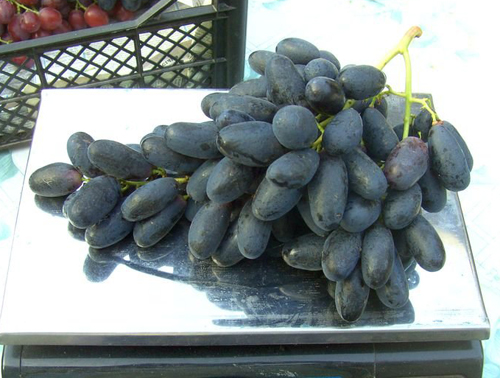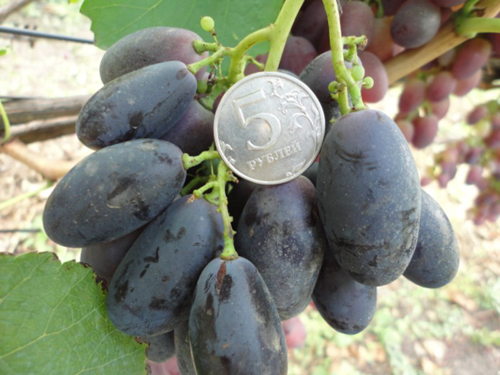Velika grape variety
The table grape variety Velika, which means “big” in Bulgarian, is a recent guest on domestic farms and household plots. Despite the fact that more than thirty years have passed since its inception, it has become widespread in the post-Soviet space only in recent years, but instantly attracted the attention of winegrowers due to its very large, tasty, dark-colored berries and the high presentation of the bunches in general. The interest in the “new product” at a certain moment was so great that at a certain stage its seedlings at a certain stage in price exceeded the cost of other, no less worthy varieties. The word "novelty" is placed in quotation marks for a reason. After all, if we plunge into the history of the appearance of Velika, then we learn that it was bred in 1987 at the Obraztsov Chiflik Institute of Agriculture and Seed Production (Rousse, Bulgaria), and in 1997 it passed the state test at home and was included in the local register of approved varieties. For many years it has been widespread and popular throughout the Balkan Peninsula, as well as in Turkey and even in northern Africa - in particular in Morocco. He came to our country much later, starting his triumphant march with a rush of interest in him, only slightly dormant by now.

The author of the bestselling book is Ivan Todorov, professor of the above-named Institute. To breed it, the scientist crossed the old Turkish grapes Karaburnu (Bolgar) with another "veteran" - French Alphonse Lavalier, and then self-pollinated the resulting hybrid. At one time, Alphonse Lavalier served as the paternal form for an even more famous variety Cardinal... By the way, the Bulgarian Velika in terms of the degree of unpretentiousness and resistance to diseases turned out to be somewhat better than its American half-brother, although he did not go far from him in terms of frost resistance. However, despite all the costs and laboriousness of cultivation in a temperate climate, fans of our hero remain crazy about him, continuing to actively multiply and expand the geography of his cultivation.
It is also worth noting that the “big” is Velik not only because of the giant berry, but also because of the fantastic vigor of growth associated with its inherent transgression of this trait, transmitted from the parents. Thanks to such a powerful development, the variety is very fond of the inhabitants of the Crimea and the Black Sea coast of the Caucasus, where it succeeds very well in arched and arbor formations, without fear of damaging the non-covering grape bushes by low winter temperatures.
Agrobiological characteristics
Plants are large, vigorous, fast-growing. The crown of a young shoot is greenish-bronze, shiny, without pubescence. The leaf is medium in size, five- and sometimes even seven-lobed, strongly dissected, rounded, with a smooth surface and a finely wrinkled back. The upper lateral notches are very deep, closed with an ovoid lumen and a rounded bottom, the lower ones are shallower, but also closed. The petiole notch can have a variety of shapes: from closed narrow elliptical to open lyre. The petioles are medium in length, on the upper side they have a number of longitudinal stripes of red-brown color, tightly adjacent to each other. The teeth on the upper edge of the leaf blade of grapes are triangular, medium in size; on the sides - passing from triangular to dome-shaped. Veins on leaves are moderately developed, without pubescence; at the base as well as at the top are red-brown. In autumn, before the fall, the foliage of Velika takes on a fiery red color. The flowers of the variety are bisexual, they are well fertilized with their pollen, there is no tendency to pea.

The bunches are large, about 18 cm long, 13 cm wide, conical or cylindro-conical, moderately dense, but not enough to deform the berries. The average weight of a hand is 500-700 grams, some reach a kilogram.The comb is of medium length, light green, strong. The berries are aligned within the bunch, excellent in size - with an average length of about 38.5 mm and a diameter of up to 23 mm. The largest are 55 mm long. The shape of the grapes is oblong with pointed tops, the color is dark blue or dark purple, the average weight is 14 grams, the maximum is more than 20 grams. Velika's flesh is dense, crispy, yellowish-green in color with a harmonious noble taste, reminiscent of the parent Asian variety Karaburnu. Uncolored juice, sugar content 16-17 grams / 100 cubic meters. cm, acidity - 5-6 grams / cubic dm. The skin is of medium thickness, covered with a thick protective coating of wax, fragile and edible. The compressive strength of the berry is 2300 grams, and the separation from the stalk is 540 grams. The bones are dark brown, rounded pear-shaped with a short beak, medium in size and well separated from the pulp. In the structure of the berry, pulp occupies 93.3%, skin - 5.4%, seeds - 1.2%. The grape tasting score is high.
The crop is successfully used fresh, but large dark-colored berries look great in various home preservation - compotes and jam. The bunches have a very attractive appearance, which, coupled with excellent taste, determines the increased interest of buyers in it. According to wine growers involved in the cultivation of crops for commercial purposes, Velika is currently one of the most “marketable” and high-quality varieties in its segment in terms of ripening times. In addition, it is also distinguished by excellent transportability, as well as a good ability to be stored in refrigerated chambers, which significantly expands the possibilities for its implementation.
Removable ripeness of grapes occurs in medium terms. It takes about 130 days from budding to ripening (in the southern regions of our country this is the end of August), and for this the plant needs a total of at least 2700 ° C active temperatures. Thus, the northern border of the possibility of growing Veliki in the open field runs along the line of Saratov, Voronezh, Kursk, Chernigov, but even there there is a danger of insufficient ripening of the crop in cold years. The resistance to winter frosts in the Bulgarian guest is not high enough (-21 ... -22 ° С), and therefore, in the conditions of the domestic climate, it is grown almost everywhere in the covering culture. Also, the variety can be damaged by late-spring frosts, but the yield is even in this case due to the productivity of replacement buds.

The grape yield is exceptionally high. At home, cultivated on powerful high-stem formations, Velika shows a phenomenal result - 32-35 t / ha, or about 10 kilograms per bush at a planting density of about 3300 plants per hectare. Domestic growers get no less result even on the covering bushes, although the feeding area is somewhat increased. It does not show a significant tendency to overload the crop, so it does not require special efforts to standardize it. The bunches are well preserved on the bushes after ripening, without loss of taste and marketability. Grapes are protected from damage by wasps with a fairly strong skin, but in autumn they can become easy prey for birds. Also, in unfavorable conditions associated with excessive soil moisture, or its sharp drop, a small part of the berries may crack.
Agrotechnical features
Velika is a purebred representative of the European-Asian grape species Vitis vinifera, which determines its not the highest indicators of resistance to harmful fungal diseases and frost. This fact, as well as some other features of the variety, require the grower to pay heightened attention to it and conscientious full-fledged care.
Planting is carried out mainly by grafted seedlings, and not only because of the susceptibility to phylloxera, but also because of the overly active growth of own-rooted plants. Therefore, among the rootstocks, it is necessary to choose those that will restrain the irrepressible growth of Veliki, in particular such as Berlandieri x Riparia CO4 and Chassela x Berlandieri 41B. The variety has good intergrowth with them.
It is often necessary to start forming the skeleton of a plant in the very first year after planting grapes. To obtain the most widespread covering formation in our country on the principle of a multi-arm fan, in the first year after planting, up to four shoots are grown on the bush, which will become its future sleeves. In the spring of the second year, the sleeves are tied horizontally to the trellis and cut to the required length, in accordance with the distance between the plants in the row. During the growing season, the first fruitful vines grow from the buds of the arms. In the fall, in front of the shelter, they are cut out, leaving only the well-ripened shoot closest to the base of the bush, which will become a new fruit arrow next spring. At this point, the plant can be considered complete, and pruning operations in future seasons will exactly repeat the previous ones. Shelter of grape vines for the winter is carried out, as a rule, by the ground, or by the formation of a light thermal insulating layer of organic materials (straw, sawdust, foliage, reeds), followed by protection from moisture. You can also use film tunnels, and in places with a consistently high snow cover in winter, simply remove the sleeves from the trellis and lay them on the ground. In the warmest regions of cultivation, in the Crimea and on the Black Sea coast of the Caucasus, Velika is not sheltered at all, forming on a high trunk with powerful cordons, and even planting arches and gazebos with it. With a horizontal arrangement of one-year growth, the variety somewhat reduces its unrestrained growth and uses much more vital energy to form the crop.
The pruning of fruit arrows of grapes is carried out quite long - by 10-12 eyes, loading the bushes with an average of 35-45 buds. Barren and weak shoots are removed in the course of debris. Inflorescences are thinned out only if you want to grow clusters of the largest possible size. At the same time, vigorous bushes adequately “pull out” even the most abundant harvest. During the ripening period, do not forget to lighten the bunches, thanks to which they will receive more sunlight to achieve the best conditions, and air to prevent fungal diseases on berries, which by that time can no longer be treated with chemicals. Only in the sultry south it is worth refraining from such a procedure, since bare bunches of grapes can get serious sunburn.
During the growing season of Veliki, it is necessary to pay great attention to the fight against diseases that actively attack the variety. You can develop a standard comprehensive protection scheme and spray the plants without waiting for them to be damaged by pathogens, or carefully monitor the appearance of the first foci of infection, immediately identify the disease and take measures to eradicate it. The first option is preferable, although it requires more consumption of chemical plant protection products. In the second case, you can get a more environmentally friendly grape harvest, but there is also a risk of losing it in the event of incorrect identification of the pathogen or ineffectiveness of the means to combat it.
In principle, with a fairly competent approach, knowledge and consideration of the peculiarities of the variety, Velika is ready to please its owners with consistently high and high-quality harvests, for which we love our already large army of fans.








